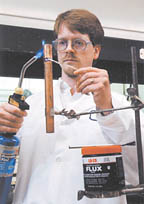Flux Basics for the Plumbing Professional
One product in the plumber's toolbox that is used practically everyday and probably taken for granted is soldering flux. First introduced over 100 years ago, flux technology has seen rapid changes and improvements in the past several years. Let's examine the various types of flux currently on the market, and look at how to more effectively use this essential product.
Functions of Flux
A high quality flux will perform three major functions:
- Clean the metal surfaces to ensure good solder flow.
- Promote the flow of solder around the joint.
- Protect the surface from recontamination.
The word flux literally means to flow or flowing, and describes one of the chief aims of a quality flux, to help the solder "flow" around the fitting as it is sweated to the pipe or tube. The flux is able to do this by governing three events that take place during the soldering process. The first of these events is the cleaning of the metal surfaces.

Oxides and dirt are removed by the flux at elevated temperatures exposing a fresh, clean surface for the solder to bond with. Then the flux functions to protect this newly created surface from becoming re-contaminated. Finally, the flux controls the surface tension of the metal surface and the molten solder to draw the solder along. Without a flux performing these three critical tasks during a soldering operation, molten solder would simply drip off the surface of the material without any bonding. Try soldering with no flux and prove to yourself what a difference it makes.
Forms of Flux
Flux comes in two basic formats: liquid and paste. Liquid fluxes are generally used for small, intricate parts. Paste fluxes are generally used for plumbing and piping and other situations that call for larger quantities of flux to be applied to a part before soldering. Paste fluxes are generally applied with a brush.
Types of Flux
Although the underlying chemistries can be very complicated, there are really only a few basic categories of flux. By knowing what the strengths and weaknesses of each type are you will be able to choose the right flux for the job.
1) Water Soluble (non-ASTM B-813) Flux
A general-purpose type of flux that is good for many types of metals and solders. They can have a higher content of active ingredients, making them very good at metal cleaning and surface tension control for superior solder flow. Their main weakness is that they can char more easily and also may cause discoloration of the surface. This discoloration does not negatively affect the metal and is easily removed. Because they are water-soluble, any residue left after soldering is easily rinsed away. Therefore, the main reason to use this type of flux is for excellent solder spreading and good rinsing capabilities.
2) ASTM B-813 Compliant Flux
An ASTM B-813 compliant flux is designed to be less corrosive and water-soluble. ASTM B-813 is a standard that specifies the functionality of the flux and is meant specifically for copper plumbing. To maintain low corrosion potential, these fluxes have lower levels of active ingredients. This can potentially reduce the cleaning ability and solder flow of these fluxes. They are also prone to charring. Being water-soluble means that any residue is naturally rinsed away. This flux should be used if the ASTM B-813 standard is enforced in your area.
3) Petroleum-based (or Petrolatum) Flux
Another general-purpose type of flux is a petroleum-based flux, and usually contains the highest levels of active ingredients available. They generally are more acidic, potentially increasing environmental hazards. A petroleum flux has very good resistance to over-heating and burn-off; and is less likely to discolor the metal surfaces. However, they can be less effective at promoting solder flow. The grease in these fluxes are inherently water-insoluble, which means residue is difficult, if not impossible, to flush with water. The main reason for choosing this type of flux is if you need the extra heat resistance.
4) Specialty Flux
There are specialty fluxes that are specifically designed for more exotic metal / solder combinations. Examples include stainless steel, aluminum, and silver solder. Obviously these fluxes should be used with the specific material you are working with.
Using Flux Effectively
Here are some tips for making sure you are using flux effectively to make the best possible solder joints:
- Select the proper flux for the application, the solder, and the surface metal.
- Pre-clean surfaces as much as possible. Remove any burrs, heavy oxide films, or ink stamps by rubbing with an abrasive pad. Dirty copper is more difficult to solder and will give inconsistent results.
- Apply small amounts of flux to both surfaces to be joined. Too much flux wastes material and can cause excessive spattering. Flux on only one surface can cause weak joints.
- Gently and evenly heat both surfaces to be joined. Uneven or inadequate heating will cause poor solder flow. Overheating can also cause poor solder flow by decomposing the flux. Ideally the surfaces to be joined are heated to just above the activation temperature of the flux and the melt/flow point of the solder.
- Work as quickly as possible without using excessive heat. Try to heat and solder the part in less than 15 seconds to avoid decomposing flux.
There are numerous brands and types of fluxes on the market. Hopefully, the information contained here will allow you to choose the best flux for the job and use it more effectively.
"This article was originally posted on ww.reevesjournal.com."
Looking for a reprint of this article?
From high-res PDFs to custom plaques, order your copy today!





